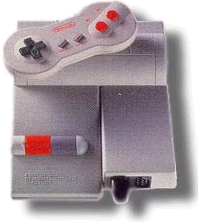NES 2
|
|
The NES 2 is a compact redesign of the original Nintendo Entertainment System (NES) video game console from Nintendo. It was released in North America in 1993 and retailed for $49.99 USD. The chassis design utilized in the NES 2 is basically identical as the design of the AV Family Computer, which was released in Japan at roughly the same time.
The internal hardware of the unit remained essentially unchanged from the earlier model, with the exception of the removal of RCA composite video output jacks (a significant difference from the AV Famicom), and the removal of the 10NES authentication chip. The external appearance, on the other hand, was greatly overhauled, restyled to resemble the North American Super Nintendo Entertainment System, and to address a number of commonly cited ergonomic problems of the original NES deck.
The first and most obvious change was the removal of the "pop-in spring" system that caused no end of trouble in maintenance and game-swapping when using the original NES. In that system, the user had to first open the lid of the case, slide in the cartridge, then press it down, compressing a spring and locking it against the contacts. Dust was the first problem with this: the large space inside allowed plenty of room for dust to settle, and the contact heads were almost impossible to access and clean without unscrewing the case. Wear and tear was the other problem: With continued use, the precision of the mechanism deteriorated and the user would have to poke and nudge at the cartridge to move it to a position that would be read correctly. The NES 2 returned to the standard top-loading method, used by almost all cartridge systems before and since for its ease and reliability. The power and reset buttons, while never a problem with the original design, now matched the curvature of the new look.
The second change was in the design of the game controllers, which were also sold separately from the deck. Like the console itself, the new controllers were restyled to resemble the SNES dog bone controller, with rounded edges that caused less stress on the hands than the old rectangular design. One could buy plastic slip-ons for the old design that had the same effect, but they were bulkier.
Despite the fact that the system had significant improvements to the original "toaster" model, the NES 2 has been widely considered a failure at the time for a number of reasons. While it did have the same internal design as its precursor, many users experienced problems with devices like the Game Genie (although Galoob quickly released an adaptor to allow the device to be reliably used with the new model). In addition, NES cartridges were designed to be inserted horizontally, and the top-loading mechanism, while a major improvement in the sense that it was hardier and less prone to breakdown than the original NES front-loading mechanism, often caused inserted games to wobble, sometimes disturbing the image projected to the user's television screen. Slightly darker displays, as well as some scan and column lines were seen in certain games and were a result of the poor quality of the included AC adaptor, and the lack of composite output capability (A/V Jacks). Though this was not generally seen as a major flaw, it was one of the most noticeable things about the console. In addition, the NES 2 was released very late in the NES's life cycle, and many users had already moved on to newer, 16-bit consoles.

